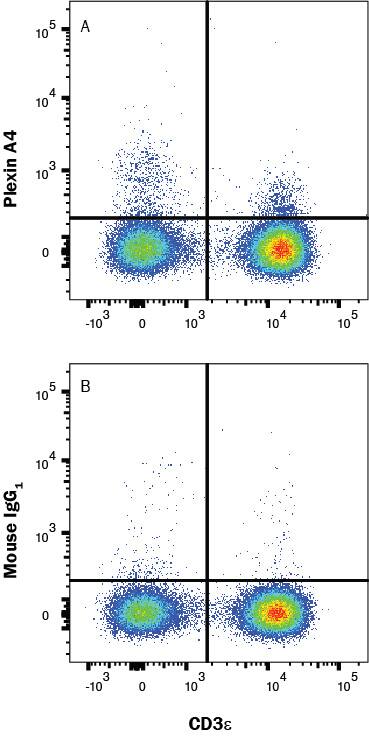Human Plexin A4 PE-conjugated Antibody
R&D Systems, part of Bio-Techne | Catalog # FAB58561P


Key Product Details
Species Reactivity
Applications
Label
Antibody Source
Product Specifications
Immunogen
Thr24-Pro1237
Accession # Q9HCM2
Specificity
Clonality
Host
Isotype
Scientific Data Images for Human Plexin A4 PE-conjugated Antibody
Detection of Plexin A4 in Human Blood Lymphocytes by Flow Cytometry.
Human peripheral blood lymphocytes were stained with either (A) Mouse Anti-Human Plexin A4 PE-conjugated Monoclonal Antibody (Catalog # FAB58561P) or (B) Mouse IgG1Phycoerythrin Isotype Control (IC002P) and Mouse Anti-Human CD3e APC-conjugated Monoclonal Antibody (FAB100A). Staining was performed using our Staining Membrane-associated Proteins protocol.Applications for Human Plexin A4 PE-conjugated Antibody
Flow Cytometry
Sample: Human peripheral blood lymphocytes
Formulation, Preparation, and Storage
Purification
Formulation
Shipping
Stability & Storage
- 12 months from date of receipt, 2 to 8 °C as supplied.
Background: Plexin A4
Plexin A4 is a 220‑230 kDa member of the plexin A subfamily, plexin family of proteins (1). It is found on sensory, autonomic and motor neurons and oligodendrocytes, plus T cells and dendritic cells (1‑8). Mature human Plexin A4 is an 1871 amino acid (aa) type I transmembrane glycoprotein with a 23 aa signal sequence, a 1214 aa extracellular domain (ECD), and a 636 aa cytoplasmic region. The ECD contains one Sema-domain (aa 51‑482), three PSI domains (aa 509‑856) and four IPT regions (aa 858‑1230) that contain a phosphoserine at aa 946 (1). Of three isoform variants, one shows a 65 aa substitution for aa 458‑1894, a second shows an 80 aa substitution for aa 1292‑1894, and a third shows the just mentioned 80 aa substitution coupled to a 14 aa substitution for aa 1‑535 (9). The human Plexin A4 ECD shares 97% aa identity with mouse, equine, canine, and bovine Plexin A4. Full‑length Plexin A4 also shares 67% aa identity with the most related family member, Plexin A2. Plexin A4 regulates cell migration, activation and axon guidance via repulsion (1‑5). It serves as a receptor for transmembrane semaphorins, Sema6A and 6B, and as a coreceptor with neuropilin-1 for the secreted semaphorin, Sema3A (1‑8). During development, it plays a role in nerve migration and midline crossing and down‑regulates dendrite formation (2‑8). It is often co‑expressed with Plexin A3, which can also engage class 6 semaphorins but prefers Sema3F/neuropilin‑2 to Sema3A/neuropilin-1 (3, 8). Thus, Plexins A3 and A4 are redundant in some functions, but unique in others. In T cells, Plexin A4 engages Sema3A and negatively regulates TCR signals (6).
References
- Suto, F. et al. (2003) Mech. Dev. 120:385.
- Suto, F. et al. (2005) J. Neurosci. 25:3628.
- Faulkner, R.L. et al. (2008) Neural Dev. 3:21.
- Waimey, K.E. et al. (2008) Dev. Biol. 315:448.
- Runker, A.E. et al. (2008) Neural Dev. 3:34.
- Yamamoto, M. et al. (2008) Int. Immunol. 20:413.
- Okada, A. et al. (2007) Biochem. Biophys. Res. Commun. 352:158.
- Yaron, A. et al. (2005) Neuron 45:513.
- Protein Accession # NP_861440, EAW83796, EAL24077.
Alternate Names
Gene Symbol
UniProt
Additional Plexin A4 Products
Product Documents for Human Plexin A4 PE-conjugated Antibody
Product Specific Notices for Human Plexin A4 PE-conjugated Antibody
For research use only